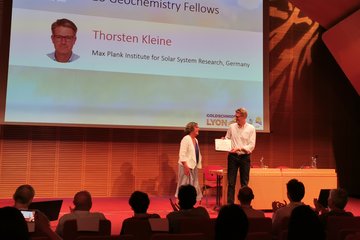Alle Typen
121.
Vortrag
La extraña química de la atmósfera de Titán vista con el Observatorio Espacial Herschel. Seminar, Caracas, Venezuela (2015)
122.
Vortrag
La extraña química de la atmósfera de Titán vista con el Observatorio Espacial Herschel. Seminar at the Center of Physics, Caracas, Venezuela (2015)
123.
Vortrag
La extraña atmósfera de Titán vista con el Observatorio Espacial Herschel. La Astronomia toma a Caracas, Caracas, Venezuela (2015)
124.
Vortrag
Spectroscopy of atmospheric trace gases on Titan with Herschel: Advances and Discoveries. ALMA/Herschel Archival Workshop, Garching, Germany (2015)
125.
Vortrag
Spectroscopy of atmospheric trace gases on Titan with Herschel: Advances and Discoveries. ESA SRE Science Workshop, Aranjuez, Spain (2015)
126.
Vortrag
Hydrogen Cyanide in the Stratosphere of Titan. 12th Annual Meeting Asia Oceania Geosciences Society, Singapore (2015)
127.
Vortrag
Hydrogen Cyanide in the Stratosphere of Titan. 12th Annual Meeting Asia Oceania Geosciences Society, Singapore (2015)
128.
Vortrag
Distant activity of comet C/2006 W3 (Christensen) as observed with Herschel. Asteroids, Comets, Meteors, Helsinki, Finland (2014)
129.
Vortrag
Detection and characterization of Ganymede's and Callisto's water atmospheres. 11th Annual Meeting, Asia Oceania Geosciences Society, Sapporo, Japan (2014)
130.
Vortrag
APEX submillimetre observations of HCl and HDO in the mesosphere of Venus. 40th COSPAR Scientific Assembly, Moscow, Russia (2014)
131.
Vortrag
Exploring external time-dependent sources of H2O into Titan's atmosphere. European Geosciences Union General Assembly 2014, Vienna, Austria (2014)
132.
Vortrag
The origin of external oxygen in Jupiter and Saturn's environments. Semaine de l'Astrophysique Francaise, Paris, France (2014)
133.
Vortrag
Characterizing the Kuiper belt with SPICA/SAFARI. SPICA Science Workshop, Leiden, Netherlands (2014)
134.
Vortrag
Tracing the gas composition of Titan's atmosphere with Herschel: Highlights. 40th COSPAR Scientific Assembly, Moscow, Russia (2014)
135.
Vortrag
Tracing the gas composition of Titan's atmosphere with Herschel: Advances and Discoveries. 46th Annual Meeting of the Division for Planetary Sciences, Tucson, AZ, USA (2014)
136.
Vortrag
The HCN distribution in the stratosphere of Titan: an intercomparison between the HCN distributions obtained with Herschel/PACS and APEX-2. Asia Oceania Geosciences Society (AOGS) 11th Annual Meeting, Sapporo, Japan (2014)
137.
Vortrag
Submillimeter Observations of Chlorine-bearing Molecules in Venus Middle Atmosphere. Asia Oceania Geosciences Society (AOGS) 11th Annual Meeting, Sapporo, Japan (2014)
138.
Poster
Investigating Physical and Chemical Mechanisms in Planetary Atmospheres and their impacts on the observables. Exoplanet III online, Heidelberg, Germany (2020)
139.
Poster
Investigating Physical and Chemical Mechanisms of Planetary Atmospheres: A DFG Project Characterizing Planetary Atmospheres Inside and Outside Our Solar System. Tackling the Complexities of Substellar Objects: From Brown Dwarfs to (exo-)Planets, Leiden, The Netherlands (2020)
140.
Poster
Chemical compositions of atmospheres of planets of the Solar System from spectroscopy. ARIEL Science, Mission and Community Conference 2020, Noordwijk, Netherlands (2020)











